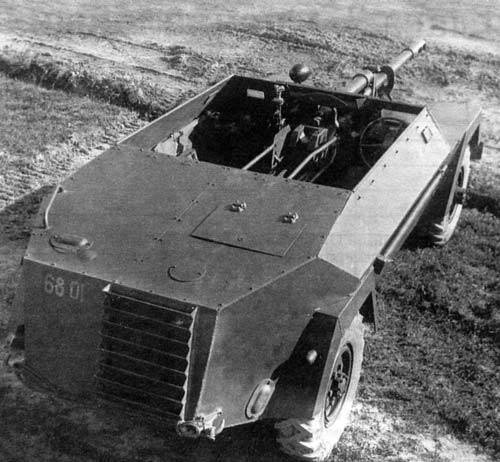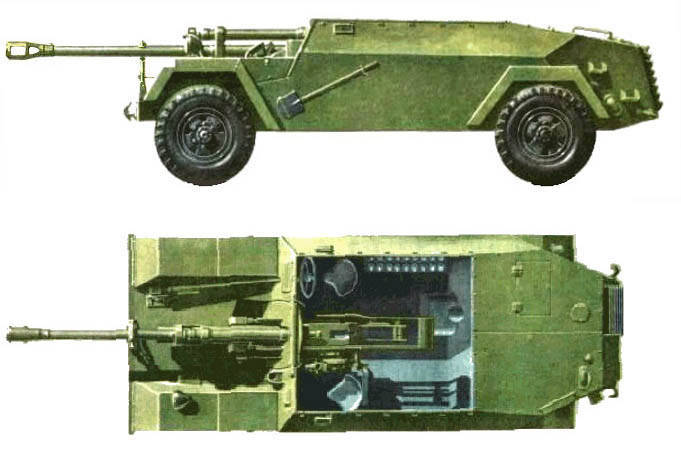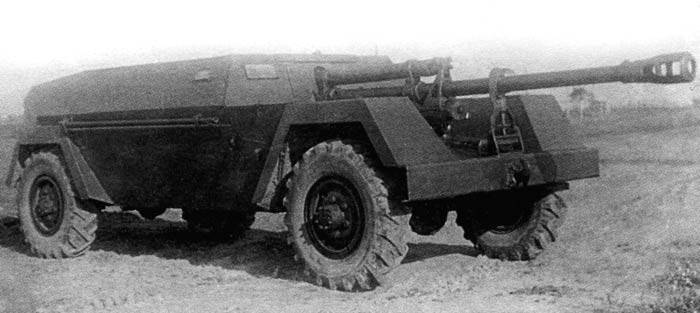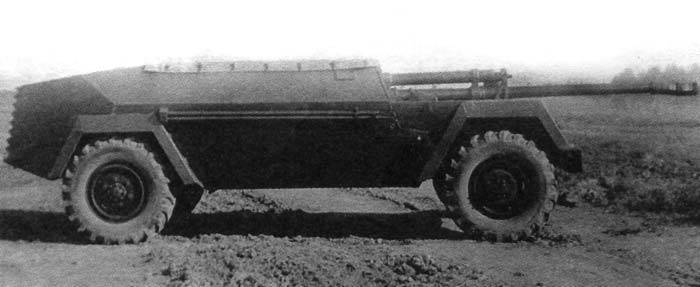Wheel SAU GAZ-68 / KSP-76

Work on the new project, which received the designation "product 68-SU", started in October 43-th. A little later, the project changed its name to GAZ-68. Design work went pretty quickly. Already in December, the 1943 of the year at the Gorky Automobile Plant collected a wooden model of a promising self-propelled gun on a wheeled chassis. In the middle of December, GAZ designers sent 43-th to the GBTU project documentation. After completing some of the improvements proposed by the Main Armored Office, the project was approved. The construction permit for the GAZ-68 prototype was obtained on February 7 of the year 1944. It is noteworthy that by this time another self-propelled designation appeared in the documents - KSP-76 (“Wheeled self-propelled gun with mm 76 caliber gun”).
Without waiting for the completion of the design work, the design bureau began to transfer documentation on the new project to the car factory workshops. Due to this, despite the loading of the enterprise, in the beginning of April the production of the first KSP-76 armored hull was completed, and after about a month the finished machine left the assembly shop.
Significantly reduce the development time of a promising ACS helped the use of the finished chassis. As the basis for the KSP-76, the all-wheel drive chassis of the GAZ-63 truck, created before the war, but not yet launched into mass production, was chosen. The design of this truck with a wheel formula 4х4 started in spring 1938 of the year, and in March of 39-th two prototypes were built. Subsequently, the Gorky Automobile Plant was engaged in testing and finishing the truck, but the beginning of the war led to a slowdown or suspension of all promising projects.

About the project GAZ-63 was remembered only in 1943 year. First, in connection with the development of a promising wheeled ACS, and later in the context of creating a new all-wheel drive truck for the needs of the army and national economy. In the autumn of 43, a new prototype machine was even built, which differed from the previous prototypes in the cabin and in some details of the design. Chassis remained the same.
As conceived by V.A. Grachev and his staff, using the existing and tested machine as the basis for a new project, was to accelerate the development of KSP-76, as well as facilitate the serial construction and maintenance of self-propelled guns. In addition, the wheeled chassis had to provide high enough performance when driving on roads and, in some cases, off-road. Wheel ACS could complement existing tracked vehicles.
Since the basis for KSP-76 was chosen truck, the designers GAZ Yu.N. Sorochkin and A.N. Kirillov had to develop an original armored hull designed to protect the crew and units of the vehicle from bullets and shell fragments. The hull was a complex-shaped structure, welded from armor panels of various thickness. The front sheet initially had a thickness of 10 mm, later this parameter increased to 16 mm. The sides and bottom had a thickness of 7 and 4 mm, respectively, and the engine compartment on top was covered with a 5-mm sheet. In front of the hull, between the wheel arches, there was a flat platform for mounting the gun. Behind this platform there was an inclined frontal hull sheet, behind which there was a fighting compartment. The latter did not have a roof. The aft of the hull had a characteristic oblique shape. Due to the use of several interesting layout solutions, the SAU KSP-76 case had an acceptable level of protection, but its weight did not exceed 1140 kg.
The gun ZIS-3 caliber 76 mm was located in front of the machine on the machine, allowing to direct it in two planes. The original placement of the gun between the wheel arches, significantly rising above the platform, was proposed to reduce the height of the entire combat vehicle in order to increase survivability and stability when moving. The machine tool made it possible to direct it in a horizontal plane within a sector of width 37 °. Allowable vertical guidance angles range from -3 ° to + 15 °.
Characteristics of the ZIS-3 gun after installation on the wheeled vehicle almost did not change. Restrictions on the angles of vertical alignment led to some reduction in the maximum firing range (which, however, did not cause any complaints, because the KSP-76 was supposed to shoot only direct fire), and the rate of fire was limited to 8 shots per minute. In the fighting compartment managed to place 58 unitary shells caliber 76 mm. 41 ammunition was placed in the aft installation in a horizontal position, 17 - to the right of the gun in a vertical installation.
Inside the fighting compartment, to the right of the breech of the gun, there was a control post with a driver’s workplace. To the left of the gun was the sight and the gunner’s place. The gunner also served as commander and radio operator. For the gunner placed folding seat loader. The crew had viewing instruments to monitor the environment, and there was a panorama of the commander’s workplace. As an additional weapons For self-defense, two PPSh submachine guns with 12 magazines (852 cartridges) were offered.
The engine compartment was located at the rear of the hull. Engine GAZ-202 installed with a shift from the axis of the machine to the right by 276 mm. To the left of the engine and transmission assemblies placed an isolated fuel tank with a volume of 140 liters and the main stack of ammunition. To cool the engine in the stern sheet was provided grille.


The basis of the KSP-76 self-propelled propulsion system was a GAZ-202 carburetor gasoline engine with a power of 85 hp. The engine was associated with a five-speed manual gearbox with remote control from the driver's seat. From the gearbox, the torque was transmitted to the two driving axles by means of a transfer case and three drive shafts. The shafts and the box were in a special tunnel that ran along the body of the car. The front axle received a permanent drive, rear - switchable.
Both self-propelled axles were made rigid and fastened to the chassis frame with leaf springs with hydraulic shock absorbers. The wheels of an experimental car were equipped with single-ply bullet-resistant tires. To improve cross-country traffic, tires had developed lugs.
The prototype SAU GAZ-68 / KSP-76, built in the spring of 1944, clearly demonstrated the advantages of the layout solutions used. With a total length (with a gun) 6,35 m and width 2,05 m, the self-propelled gun had a height of just 1,55 m. Thus, the KSP-76, with similar firepower, was 70 cm below the SU-76 self-propelled gun, which should have a corresponding impact on its survivability combat conditions, but to some extent limited the combat capabilities. The combat weight of the machine was 5430 kg.
In the late spring of the 1944, the factory launched tests of the new self-propelled guns. On the highway, the combat vehicle accelerated to 77 km / h. Cruising on the highway - 580 km. Thanks to the use of the wheeled chassis, the KSP-76 had a number of advantages over the tracked SU-76 and its simplified version of the OCU-76, which was being developed at the same time. The wheeled combat vehicle was faster on the highway, quieter and lower. However, self-propelled tracked vehicles had the best characteristics when traveling over rough terrain.
The first stages of testing were accompanied by a host of problems and problems. So, there were regular breakdowns of the undetected front axle, gearbox and drive shafts. In addition, it was noted that the combat compartment of self-propelled guns is insufficient and not very convenient for the crew. By the middle of autumn, factory tests were completed in Gorky, after which the new GAZ-68 / KSP-76 self-propelled gun could be transferred to the Kubinka Scientific Test Armored Range. It is noteworthy that all the way from Gorky to Kubinka, including the icy sections of the highway, the wheeled self-propelled guns passed its course at an average speed of 60 km / h.
The test report conducted on 17 on 24 December 1944 of the year highlighted the advantages of ACS KSP-76 associated with the used armored hull design. In particular, they talked about a relatively small mass of the machine and its small dimensions. The accuracy of the fire of the ZIS-3 gun was at the level of the table. However, as it turned out during the tests, the self-propelled gun had to be fired only from a short stop, because when shooting in motion the accuracy sharply decreased.
The commission that carried out the tests recommended correcting the remaining minor design flaws, after which the GAZ-68 / KSP-76 self-propelled gun could be allowed for troop tests in the event of an appropriate decision by the Main Artillery Directorate. However, wheeled SAU was not recommended for adoption. In 1944, in parallel with the KSP-76, the self-propelled gun OCU-76 was developed, which was a simplified version of the SU-76. Having advantages in size, level of protection and maximum speed, wheeled self-propelled gun lost track tracked in combat weight and maneuverability on rough terrain. Moreover, the effective use of ACS KSP-76 off-road was considered impossible. Finally, the outlook for the car was influenced by the features of the GAZ-63 project. This truck, although it was tested before the war, was not built serially, which is why the start of production of self-propelled guns at its base could be associated with serious difficulties.
In the absence of prospects, the GAZ-68 / KSP-76 project was closed immediately after the completion of the tests. The only built copy of this self-propelled gun remained in Kubinka. Now he is an exhibit of the museum of armored vehicles.
On the materials of the sites:
http://aviarmor.net/
http://русская-сила.рф/
http://bronetehnika.narod.ru/
http://all-tanks.ru/
Information